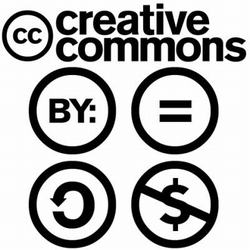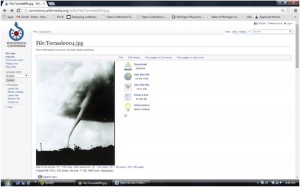Surfing with purpose: Online collections as exhibit resources (Part 2)
25 August 2014 – Theresa Koenigsknecht
Continued from Part 1.

Creative Commons offers several levels of easily-applied licenses to facilitate digital publishing of images while offering some protections to owners and creators.
Navigating copyright for images is tricky and presents one of the biggest challenges in my work as an Exhibitions Researcher at the Indiana Historical Society. Although I admit to only a rudimentary understanding of copyright, this is where open access comes in very handy. While it is certainly important to support other cultural institutions and individuals by purchasing images, the back and forth involved in determining copyright, ensuring a file is a high enough resolution, or waiting for a physical copy to be delivered doesn’t always fit into a production schedule. That is why I increasingly rely on sites with hassle-free permissions and files I can download immediately. We still always credit the source of photos used in our exhibits even if they are open access.
Issues of copyright become even more complex with online materials, and new legal conventions are emerging along with digital collections. Creative Commons is a non-profit organization that provides a way to license online images and other materials as part of a mission to expand the pool of shareable files on the Internet while giving owners and creators some legal protection and control over how their works are used. There are several levels of CC licenses enabling different levels of use. These range from CC BY, which allows any use or adaptation as long as the original owner is credited, to CC BY-NC-ND, which allows for reuse with attribution but prohibits any changes or commercial uses.

Wikimedia Commons is an easily-searchable repository of public-domain images.
Helpful databases for images:
- Wikimedia Commons: Provides media files in the public domain and operates under the same principles as Wikipedia in that anyone can edit or upload. This repository gives options for downloading various resolutions, and it is easy to browse relevant images by topic. For example, I searched the term “tornado” and chose the image shown here, dating from 1949. Not only is proof of public domain or copyright restrictions provided, but I can immediately see if the image exists in a high resolution file.
- Flickr, The Commons: Shares public photos from a variety of institutions, including the British Library, the Smithsonian Institution, and the US National Archives. Heading straight to The Commons saves you from having to sort through results with restrictions on reproductions.
- The Library of Congress Prints and Photographs Online Catalog: Although the LOC participates in Flickr, The Commons, they have their own easily navigable catalog of prints and photographs. Many of the materials in this collection are available to download at high resolution for free.
- Open Glam: This initiative stands for Galleries, Libraries, Archives, and Museums and helps institutions make their collections open access and searchable.
Usually, photographs or primary sources I find through online collections are combined with Indiana-specific items from our library and other local repositories. Supplementing IHS collections with digital sources allows us to place Indiana viewpoints within a deeper context and create more complex narratives. For example, in a recent immigration exhibit, I was able to use a Wikimedia image of the signing of the 1965 Immigration Act alongside IHS photos to illustrate national and local connections.
I can’t imagine doing my job without the above tools. Several years ago these resources might only be available to view in person, limiting the materials researchers could access and include in their work. Today the Internet and increasing open access options broaden who can create and reach collections and consequently allow for the creation of multi-perspective historical narratives.
The growth of efforts to digitize and make historical sources accessible electronically has in many ways made their use second nature, though no less remarkable or essential. Although I might not always be aware of the technical classifications of the tools I’m using, I’m using them nonetheless. Chris Cantwell articulated this well when he observed at a gathering of curators and museum educators that “they weren’t defining DH [digital history]. They were just doing it.”
While being a competent historian in today’s world means knowing how to use the best tools, there is no need to learn everything. Even without taking a course or having training, anyone can take simple steps to learn about basic resources that can increase the effectiveness of their historical work. What are your “go to” digital sources or open access collections?
~ Theresa Koenigsknecht is an Exhibitions Researcher at the Indiana Historical Society. Follow her on Twitter @TKhistarch7.




1 comment